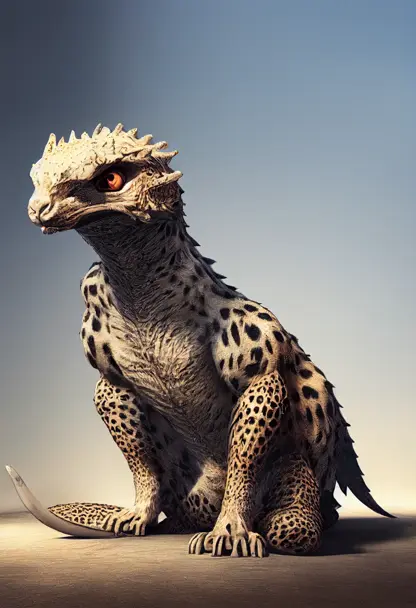Frilled Chivern (Frill-ed Chee-vern)
Frilled Chiverns are a combination of sleek grace, agility, and brutish violence wrapped in a muscular, venomous package. They are a deadly, carnivorous predator that has perfected the art of lying in wait and striking prey at high speeds, both on land and in the air. Because of this speed, they are patient hunters, able to sit silently in trees or tall grass for hours.
Typically avoiding dense or tangled undergrowth, chiverns are a common sight in warm plains, or temperate forests. Adept runners, they can reach speeds of 70 miles per hour (112.6 km per hour) when hunting. Such speeds allow them to run down prey from hundreds of feet away, where they are often out of sight, waiting motionless in tall grass.
Running isn’t their only asset. A chivern has functional wings. But, their speed in the air doesn’t compare to their speed on the ground. When in flight, a chivern is guarding its territory, or silently scouting for a meal. In combat, a chivern uses its wings to knock down, or disorient, an opponent down through buffeting them with a burst of air. Chiverns also use their wings to leap from trees, to glide silently down on prey when they don’t feel the need to run.
Basic Information
Anatomy
Chiverns are a large animal that is part reptile and part mammal; specifically, a feline. They have a head shaped similar to Earth’s cheetah with a rabbit-like nose. It has ears, though they are not easily visible as they blend in with the frill ridge that is part of the spiked brow on their head. Their amber-gold eyes are closer to a feline’s eyes than a reptile, which allows them to see well in both daylight and partial darkness. This eyesight, backed by an excellent sense of smell, is the cornerstone of how they hunt for prey.
They are a quadruped animal with muscular legs that developed for incredible speeds when running down prey. A chivern’s paws have semi-retractable claws. They can use them when attacking prey, but only when necessary. A chivern’s claws help the animal reach such sudden bursts of speed, or allow them to scale and perch in trees.
All chiverns are covered in a fine, soft tawny colored cur peppered with black and brown spots. This acts as camouflage when in tall grasslands, or their temperate forest home. They naturally produce a light oil which acts as waterproofing for their fur against rain or inclement weather.
Beyond the fur, a chivern’s body is long and streamlined, similar in shape to a thin crocodile or a dragon. It is closer to the latter because of their broad, chestnut brown, leather-like wings. A chivern folds its wings along its back in a unique double fold so that their wings lay flush against their body. This is so that their wings don’t interfere with their running speed. A chivern’s tail, which is shaped more like a feline tail than a reptile, helps the animal with balance while running, attempting flight, or balancing on unusual perches.
The most remarkable aspect of the chivern is its jaw and fangs. When a chivern hunts, the animal runs down its prey and attempts to use a combination of its speed and a quick hop with its wings to pounce. If it connects, especially if it can pin a victim to the ground, the chivern will latch onto its prey’s throat, then lock its jaw.
Once locked on, the chivern attempts to inject a venom into its prey to subdue it. This venom is a paralytic, which numbs the victim’s muscles, rendering them helpless in minutes. After that, the chivern strangles its prey to finish them.
Ecology and Habitats
Chiverns prefer a warm, temperate climate such as the grasslands to the west of the Forest of Abundance on Sow Terra, and the Forest of Abundance itself. They often stake out a territory of 14 - 62 sq miles (35-160sq km), where the larger territory belonging to pairs of chivern or larger groups called ‘prides’. Chiverns are territorial and will viciously defend their territory against all comers, chivern or non-chivern alike.
Additional Information
Social Structure
While chiverns do hunt alone, they are social animals. They prefer to travel in pairs or with their entire social group. A collection, or extended family, of chiverns is called a pride. A chivern’s pride is nomadic, wandering through their territory between different dens near favorite hunting grounds.
A chivern pride is matriarchal, with two females sharing the responsibility of settling disputes, defending the young, and leading the group between their tree-covered dens. Males do the hunting or scouting out food for the pride.
Chivern dens are a combination of cave and ground-based nest. The size of a chivern prevents it from creating an actual nest, though it isn’t uncommon for a sole chivern to nap in a tree. Typically, chivern nests are formed from uprooting saplings to form crude ‘tree caves’, nestled against a dense patch of undergrowth for support.
For most healthy prides, a chivern den is likely to have three to six young cubs. The cubs remain with the pride for twenty to thirty months before they go form, or join prides of their own.
Lifespan
17 to 20 years
Average Height
3.5 and 4 feet (1 and 1.2 meters) tall at the shoulder
Average Weight
330 to 550 pounds (150 to 250 kilograms)
Average Length
10 feet (3 meters) with a 2 to 3 foot (60 to 91 centimeter) tail
Geographic Distribution




Comments